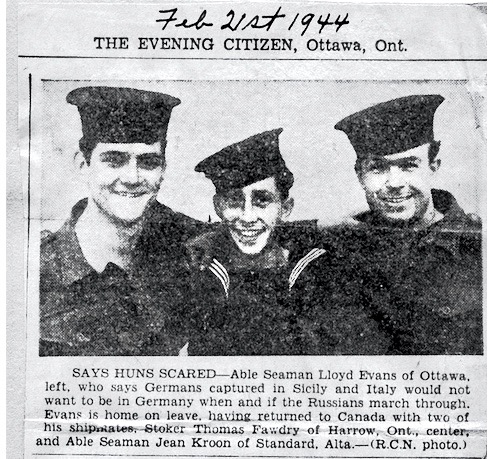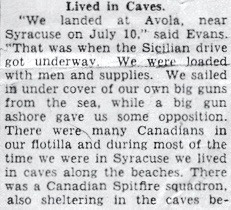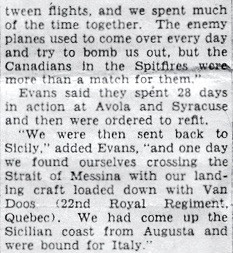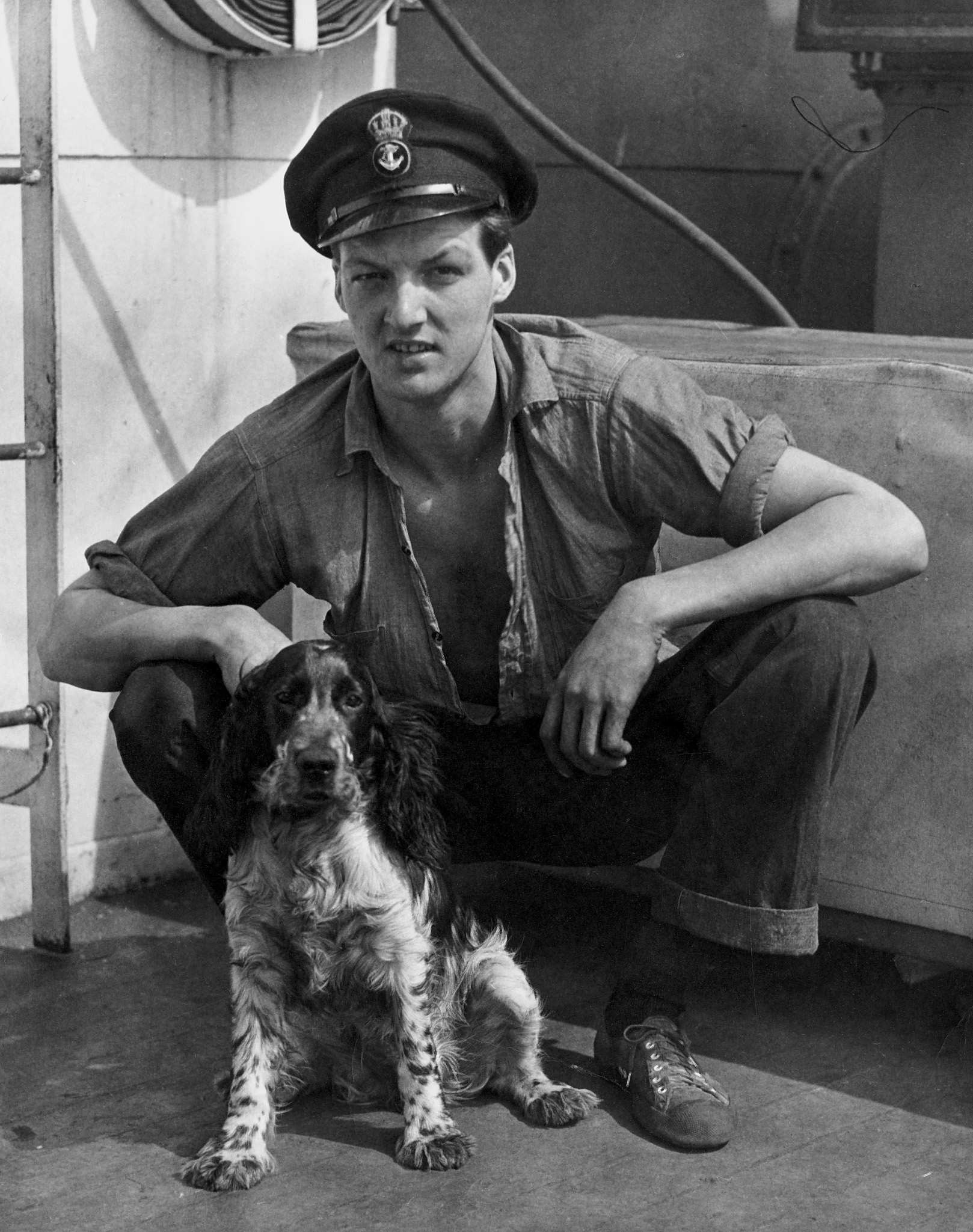Lloyd Evans, RCNVR and Combined Operations, 1941 - 1945.
An Ottawa Boy Recalls Sicily Invasion and Much More
Lloyd outside his house in Ottawa, before going overseas.
On his way to Halifax; December, 1941 or January, 1942
Introduction:
In the early days of this website I did a lot of online research to collect any material available associated with the Canadians who joined RCNVR during WW2 and subsequently volunteered to join Combined Operations (Comb. Ops) and be trained to man or handle or manhandle landing crafts as early as in the spring of 1942, months before the Dieppe Raid (the first action of early Canadian entries in Comb. Ops).
One search lead be to an extensive Combined Operations website by Scotsman Geoff Slee, and on that site I found
Lloyd's story in great detail. After reading his story I thought that he and my father had to be mates (They'd boarded the same ship in Halifax to go overseas in January, 1942. They took part in many of the same Combined Operations training camps and subsequent actions, raids and invasions), so I sought to make contact with Mr. Evans.
Subsequently, I met Lloyd a few years ago at his home in Markham, Ontario. He was in his 90s but was eager to talk about his adventures related to World War II. I gave him a copy of my father's memoirs and he gave me a copy of his own. Inside Lloyd's book was a photo in which my father appeared with a few others I was growing more familiar with, and he recalled Dad's name and appearance, but they had not been close mates.
Still, how happy was I when Lloyd's son later sent me a stash of Lloyd's photograph files, and in one photograph our fathers appear together.
Six Canadians in Comb. Operations. Lloyd is back row, 2nd from right,
Dad is front row, right. Photo from the collection of Lloyd Evans
Besides having access to Lloyd's memoirs, I have been given one newspaper interview in which Lloyd describes the invasion of Sicily, and have found one article directly linked to Mr. Evans, with references to other Canadians and their experiences during World War II as well.
The first item is seen to be from The Evening (Ottawa) Citizen and dated about two months after Lloyd and many other sailors had returned to Canada after the invasion of Italy (beginning September 3, 1943) and after two years of overseas service had gone by.
There is evidence the article is a bit longer, and portions of the above
were used in another similar interview-style article. (I'm a-hunting).
Same photo, different caption and headline from another article, which
I do not have as of yet. Caption informs us Lloyd returned to Canada aboard
HMCS Prince Robert, and landed certain Canadian troops in Italy.
I have read in Lloyd's memoirs that he did not return to Canada at exactly the same time or on the same ship (i.e., the Aquitania) as my father and Joe Watson - their interviews have been mentioned in previous posts - and that Lloyd was injured in Messina and transported to a hospital in North Africa may explain why.
That being said, while Mr. Evans participated in the invasions of Sicily and Italy, he did serve under the same commander, i.e., Lt. Jake Koyl, Saskatoon, mentioned above, and shared space inside the same caves near Avola (SE coast of Sicily; see map below) during the hot days and action in July.
Map as found in
Combined Operations by Londoner Clayton Marks
In his memoirs, Lloyd writes the following about some of his experiences in Sicily:
The initial landing was fairly quiet but, later, heavy enemy artillery opened up. This was quickly silenced by a few salvos from the 16-inch guns of a supporting Monitor. This particular Monitor was one of two shallow draft Cruisers that had been built for bombardment duties in the China seas. It had been fitted with large blisters on the sides, a kind of sacrificial layer, to reduce damage from a torpedo attack.
An hour or two into the landing, enemy planes started bombing the beach area. It was very intensive in the first 24 hours with nearly thirty raids but continued for several days at less intensive levels. The first of the raids each day were a regular wake up call in the mornings! By the waters edge and beach area there were several crashed American gliders, which had been cut loose too early and failed to reach their designated landing zones. They still had bodies in them. After several days of almost continuous bombing, our ship ran low of 20 mm Oerlikon AA ammunition. Such was the intensity of the firing, that the gun barrels overheated and were replaced by the gun crews. Until our ship received fresh supplies of ammunition, we only fired in self defence of a direct attack on our ship.
While all this bombing was hard on the nerves, it didn’t accomplish very much. However, about noon one day, three Stuka dive bombers came screaming from behind the mountain and out of the sun. They dropped three bombs, hitting two ships directly and damaging another from a near miss. For a few hours, the black smoke from the exploding ships turned day into night. On another occasion, during a heavy bombing attack, a hospital ship lying off our beach was sunk. Hundreds of bombs were dropped at this time on the numerous ships around the beach, so the incident might have been accidental. After a Canadian Spitfire squadron became operational from a nearby grass runway there was a big reduction in enemy air activity.
After we finished unloading our mother ship, it sailed off and we moved onto the beach. There was still plenty of work unloading supplies from other ships in the area. Good accommodation was hard to find, so we moved into a big cave. It was damp inside, so we put our hammock mattresses on stretchers. Even so they and our blankets were wet through in the mornings and had to be hung out to dry. Before bedding down at night, we had the ritual of shaking bugs and beetles from our beds. However, these deprivations were better by half than the ever present threat of enemy bombs. Several of our boys picked up an infection and ended up in the hospital with a high fever similar to malaria, although we had all been talking anti-malaria pills.
Our beach was near the town of Avola, part of the flank attack on the port of Syracuse by the British 8th Army. Italian POWs volunteered to unload the landing craft under the guard of a few Indian soldiers. Some of the Indian soldiers had themselves been prisoners of the Italians in the North African desert and, very much against their religion, had their heads shaved. For them, it was a very serious matter and some chose suicide, whilst others swore revenge. There were a lot of close shaven Italians in the area at that time so, to an extent, the score had been settled! One of the Indians agreed to show me his knife but only if he could cut my finger. Tradition had it that the knife had to draw blood every time it was taken out of its case, even just to sharpen it.
Our departure from the Sicilian beach was both sudden and unexpected. After about a month there, three of us decided to visit the nearby city of Avola and to trade a few cans of bully beef for wine. It wasn't entirely risk free, however. As we walked through the ammunition supply fields off the beach, we heard the sound of a sniper's bullet passing very close by. When we arrived at Avola, we dipped our tin mugs into a barrel of vino, which was conveniently located in the centre of the square. We wandered through some empty houses vacated by the owners when they fled to the hills. That evening, we fell asleep outside an air-raid shelter favoured by the local inhabitants who spread their mattresses there every night. Unfortunately an army Provost group spotted us and removed us by truck to their HQ. Not for the first time, we discovered that a city was out of bounds. We had consumed a fair amount of vino and were not too happy about this and called them several uncomplimentary Limey names. The sergeant in charge, a Scotsman, thought all this was pretty funny. He promised to send as back to the beach, by jeep, in the morning if we behaved ourselves. However, the officer in charge had other ideas but when the sergeant explained our fondness (?!) for the Limeys, he relented and we were delivered safely to the beach. When we arrived back, the flotilla was loading our gear onto our landing craft and, with an escort of Motor Launches and a Destroyer, we set off later in the day for Malta, about 75 miles to the west.
Memoirs entitled "Landing Craft Operations - North Africa, Sicily and Italy" as found at COMBINED OPERATIONS COMMAND
War correspondent Richard (Dick) Sanburn caught up to Lloyd and 4 - 5 other Canadians in Combined Operations during the early stages of the invasion of Italy in September. The full article from The Ottawa Evening Citizen follows:



While returning from a motorcycle trip to Canada's East Coast I stopped in Ottawa for a few days and happened to visit Canada's War Museum on my last day there. It was my third visit, a very important one. I not only was able to purchase two excellent Canadian history books (containing details related to Canadians in Combined Operations) but was introduced to a museum/bookroom volunteer who was a 92 or 93-year-old WWII Navy veteran, Nelson Langevin.
Nelson was not only an RCNVR veteran, he had been a member of Combined Operations (and wearing a blazer and Comb. Ops tie at the time we met), and knew Lloyd Evans and my father. He recalled to me details of a visit he had made to my parents' house in Norwich, Ontario years before. I was flabbergasted, made speechless, and later rode toward home as if on a cloud.
Once back home in London I emailed Lloyd Evans about my chance meeting with another Canadian in Comb. Ops and shortly thereafter I received his reply:
Subject: Re: East Coast trip
Thank you for that GREAT email. Sorry for delay in replying as I waited to send you some news. I got Nelson's phone number from the computer and called him but his daughter said he was out so I called him the next night and we talked for almost an hour.
I knew him very well as we were on the same ship around South Africa going to the attack on Sicily. He said he remembered the baby monkey as it slept with him one night. It made me remember a lot of things in our great talk. Hope you and your wife can visit us again soon as we all have a lot to talk about.
Lloyd
Lloyd and I did visit a few more times before he passed away. We did have a lot to talk about.
After he passed away his son Stephen sent me a large number of Lloyd's photos, and I am happy to share some of them here:
Lloyd is in the back row, fifth from the left. Most of the sailors here may have
volunteered as the second draft to Combined Operations. Halifax, late 1941
This photo is a companion to the second photo from the top of the page.
The sailor 2nd from left (above) appears beside Lloyd in the companion photo,
as well as in the class or division photo, just above this one.
Lloyd with the monkey that served as a mascot aboard ship travelling around
Africa on the way to the invasion of Sicily and Italy. Summer, 1943
Another mascot on another ship? Sailor and dog, unknown
Lloyd knew Chuck Rose, one of my father's mates as well, seen here
pushing a broom after a large ship disgorged garbage onto the LCM.
Chuck Rose (left), Al Kirby, and Lloyd Evans guarding the tank mesh!
Small craft on Loch Fyne at HMS Quebec, Inveraray, Scotland. Circa 1942
A rare photo of Richard Cavanaugh, one of Canada's casualties
during the Dieppe Raid. Location and date unknown.
Information about another Canadian in Combined Operations who made headlines will soon follow.
*The Ottawa Citizen can be found on microfiche at the University of Western Ontario (UWO) in London. Email me at gordh7700@gmail.com with any questions, comments or concerns.
Unattributed Photos GH






















No comments:
Post a Comment